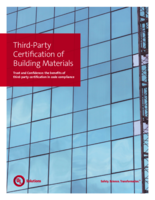
Third-Party Certification of Building Materials eBook
Navigate your business in an increasingly complex world with industry-leading research and actionable insights from UL Solutions.
Explore our press releases and news updates. Delve into detailed press kits for information on our work. If it’s UL Solutions and newsworthy, it’s here.
Connect with us in person or online, around the globe. We’re everywhere your business needs us to be.
As a global safety science leader, UL Solutions helps companies to demonstrate safety, enhance sustainability, strengthen security, deliver quality, manage risk and achieve regulatory compliance.
See how we put safety science to work to help create a safer, more secure and sustainable world for you.
Explore our business intelligence-building digital tools and databases, search for help, review our business information, or share your concerns and questions.
Accelerate your planning process and learn the requirements needed to take your products to market worldwide.
A secure, online source for increased visibility into your UL Solutions project files, product information, documents, samples and services.
Access UL certification data on products, components and systems, identify alternatives and view guide information with Product iQ.

ULTRUS™ helps companies work smarter and win more with powerful software to manage regulatory, supply chain and sustainability challenges.
Understand the nuances of self-declaration and third-party services, including the different ways to demonstrate that products comply with standards and code requirements.

Code officials, architects, specifiers, plan reviewers and other code authorities have the important responsibility of determining whether building products and assemblies comply with governing codes and regulations. While this may sound straightforward, many questions arise pertaining to such a determination:
This overview addresses these commonly asked questions and explains the important role that third-party certification plays in demonstrating code compliance for all stakeholders.
In this eBook, you will learn about the following topics:

Third-Party Certification of Building Materials eBook